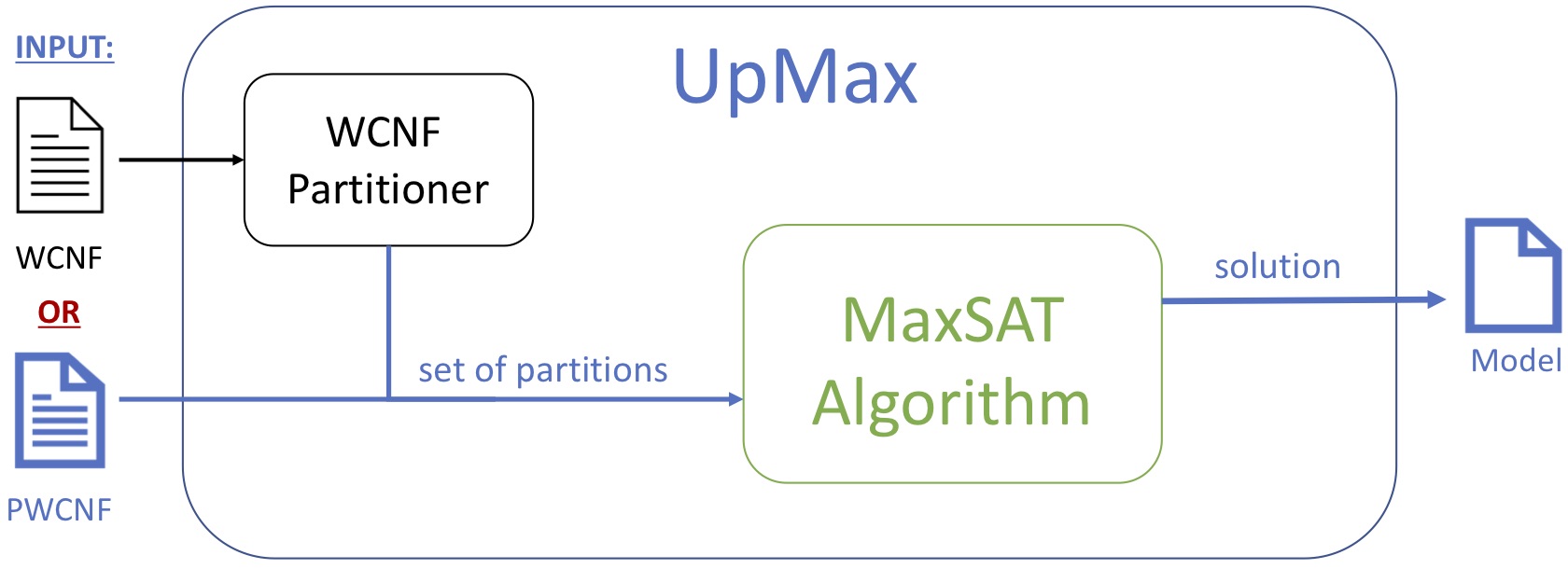We propose a new format called pwcnf for defining MaxSAT formulas that extends the current wcnf format, allowing the user to propose how to partition MaxSAT formulas based on his domain-knowledge of the problem to be solved. Moreover, until now, the partitioning of MaxSAT formulas is interconnected to the subsequent algorithm to be used. Therefore, it is not easy to define and test new partitioning methods with several MaxSAT algorithms developed by different people. This new format allows to decouple these components, hopefully facilitating the appearance of new partition methods for MaxSAT formulas.
The above figure illustrates the schematic view of the UpMax architecture based on decoupling of the MaxSAT solving algorithm from the split of the clauses on the MaxSAT formula.
We propose a new generic format for MaxSAT, pwcnf, where the partition scheme can be defined and solvers can take advantage of it. The pwcnf format starts with a header:
p pwcnf n_vars n_clauses topw n_part
and each line in the body is of the form:
[part] [weight] [literals] 0
In the header, n_vars and n_clauses are respectively the number of variables and clauses of the formula. topw is the weight assigned to the hard clauses and n_part corresponds to the number of partitions. Each partition label [part] must be a positive integer from 1 to n_part.
The user can either encode the problem directly into pwcnf format or it can transform an existing wcnf to pwcnf using an automatic extraction of partition implemented in UpMax.
The following partitioning strategies can be used:
-graph-type = <int32> [ 0 .. 3] (default: 2)
Graph type (0=vig, 1=cvig, 2=res, 3=random).
A pwcnf file can be created with the option -upfile:
-upfile = <string>
PWCNF file with automatic partition.
For example, suppose you want to automatically generate a pwcnf file from an existing wcnf file called filename.wcnf using the VIG partitioning strategy. Then you can accomplish this task with the command:
./upmax -graph-type=0 -upfile=filename.pwcnf filename.wcnf
The option -formula controls the kind of formula being solved by the solver. The following options are available in UpMax:
-formula = <int32> [ 0 .. 2] (default: 0)
Type of formula (0=WCNF, 1=OPB, 2=PWCNF).
UpMax currently supports three MaxSAT solver that can be used with user partitioning information. The option -algorithm controls the algorithm being used.
-algorithm = <int32> [ 0 .. 2] (default: 1)
Search algorithm (0=wbo,1=msu3,2=oll)
To use the user partitioning from the pwcnf file the option -upmax should be as well.
-upmax, -no-upmax (default: on)
User partitioning.
For instance, consider that you want to solver the formula filename.pwcnf with algorithm oll using the upmax option then you should run UpMax as follows:
./upmax -algorithm=2 -formula=2 -upmax filename.pwcnf
Our README explaining how to run PySAT with user-based partitions can be found here.
